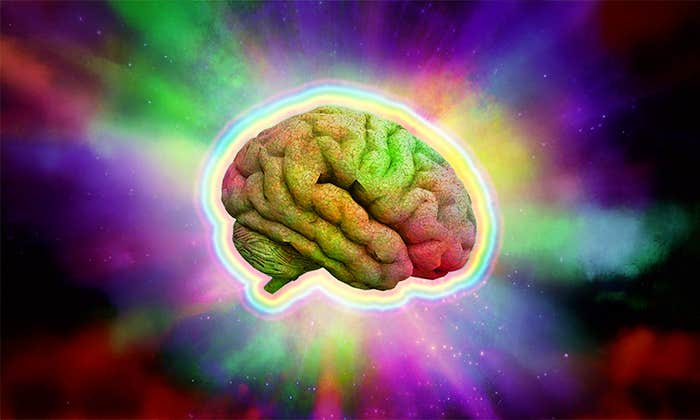The scientists crowded around Yuanchao Xue’s petri dish. They couldn’t identify the cells that they were seeing. “We saw a lot of cells with spikes growing out of the cell surface,” said Xiang-Dong Fu, the research team’s leader at the University of California, San Diego. “None of us really knew that much about neuroscience, and we asked around and someone said that these were neurons.” The team, who were made up of basic cellular and molecular scientists, were utterly puzzled. Where had these neurons come from? Xue had left a failed experiment, a dish full of human tumor cells, in the incubator, and when he looked two weeks later, he found a dish full of neurons.
It’s not often an unexpected cell type appears in a petri dish, as if from nowhere. Scientists all over the world have spent a lot of time and money actively trying to generate neurons in the lab—the implications for neurodegenerative disease would be massive. And yet this research team, who were actually studying the RNA-binding protein PTB, had unknowingly generated a whole dish of neurons.
“It puzzled me for quite a long time, and I didn’t know what was wrong with my cells,” said Xue, who is now a researcher at the Institute of Biophysics at the Chinese Academy of Sciences, in Beijing. Xue was attempting to deplete human tumor cells of PTB with small interference RNAs (siRNAs). He expected his cell lines, which are typically very proliferative, to keep growing, but they stopped, and so were cast aside for two weeks. Sure that the dish had become contaminated, Xue and colleagues tried the experiment again … and again … and again.
Not being fully aware of the field, and how they were going against the science, helped them. Their naivety allowed them to push forward.
“We tested every cell we could grab, and every single time we did the same thing—that is removing the protein PTB—and every single cell became a neuron,” said Fu. Fibroblasts, tumor cells, glial cells … The team realized every time they depleted the cell of PTB, the cell would convert into a neuron. The logical next step was to move onto mouse models of Parkinson’s disease—the progressive death of dopamine-producing neurons that causes, among other things, tremor and movement problems. As with other neurodegenerative conditions, treatment is inherently difficult and current options are not curative.1 Neurogenesis, the generation of new neurons in the brain, typically stops during puberty. So when these cells become damaged or die, the body cannot replace them.
Xue and his colleagues decided to concentrate on the substantia nigra, a region in the midbrain where dopaminergic neurons predominate and typically die during the disease. The researchers decided to try the depleting-PTB technique on astrocytes, star-shaped non-neuronal cells that are abundant in the brain. Usually they produce the RNA-binding protein PTB1, which prevents them from becoming neurons. Banking on the idea that when neurons die, astrocytes typically proliferate and fill up this space in the brain, the team thought it might be useful to convert these excess astrocytes in Parkinson’s disease into neurons in vivo, in animal models.
However, their neuroscientist peers were doubtful. In theory, Fue was told, it is not possible to regenerate a functional neuron or rebuild a neuronal circuit. Experiments in a petri dish, in vitro, can often look very different in vivo, in living organisms. What’s more, from an experimental perspective, the chances of converting astrocytes into functional neurons in vivo were looking slim.
Fu explained that not being fully aware of the field, and how they were going against the science, helped them. Their naivety, he said, allowed them to push forward. So, the team designed an adeno-associated virus to carry an siRNA, to silence the target gene that encodes PTB, Ptbp1. They injected the virus directly into the midbrain of the Parkinson’s mouse model, where the team had depleted most dopaminergic neurons with the chemical, oxidopamine. They also injected a control model with the siRNA without the vector. Fu and colleagues were able to see that 12 weeks after injection, the number of converted neurons had reached 30 to 35 percent; there were no neurons in the control model. With a series of experiments thereafter, the researchers were also able to show that not only had the astrocytes converted to functional dopaminergic neurons, these neurons progressively matured and reconstructed neural circuits in the region and restored motor deficits. Neuroscientific theory was wrong.
The team realized this technique could convert cell types into neurons specific to that region; by injecting their virus-plus-vector into the cortical region of the brain, the researchers saw cortical astrocytes convert into cortical neurons. The team showed in a recent Nature paper, published in June of this year, that they had successfully reversed symptoms of Parkinson’s disease in a mouse model.2
“Yes, these results are very unexpected,” said Xinnan Wang (who was not involved in the study) by email. Wang is a researcher in the department of neurosurgery at Stanford University School of Medicine. “[This is] a true ‘out of box’ innovation. If this mechanism works similarly in humans, it will provide a new paradigm for how we treat neurodegenerative disease including Parkinson’s disease: by simply converting patients’ own astrocytes to neurons.”
Other scientists have tried to do this before. A team from Sweden, for example, reported in a 2017 paper that they were able to convert astrocytes from a mouse with Parkinson’s disease into induced dopamine-releasing (iDA) neurons.3 The conversion rate was low, however, and the iDA neurons were not able to build a distant neuronal circuit or completely restore motor behavior.
It may be that astrocytes are constantly suppressing their development into a neuron with the expression of PTB1. That’s one explanation for why removing PTB in astrocytes converted them to fully functioning neurons specific to the region.
“My dream is, before my retirement, we can see a clinical trial and a patient benefit from this.”
Despite Xue and colleagues’ series of elegant experiments, the researchers came up against a few hurdles. They originally submitted their study to another publication, back in 2017, but were rejected. “The three peer reviewers who had looked over the paper called us themselves to congratulate us,” said Fu. According to Fu, the reviewers raved, “This is so exciting” and “this is a major breakthrough.” Fu and the team were happy the research was well received. However, the publication’s editor was very hesitant. A fourth reviewer wondered if the team had interpreted their experiments correctly. The paper wasn’t accepted.
So, the disappointed team submitted their paper to Nature, where it was eventually published. But only after a few years and a lot more work. Yet again another set of reviewers immediately called the team to congratulate them on their “revolutionary work.” And a fourth reviewer suggested a set of experiments the researchers could do to cast away any further doubt. “They suggested 28 more experiments,” Fu said. “We did every single one. That’s why the paper is so long!”
“This is very exciting and (to me) an unexpected result from a theoretical point of view,” John Hardy, a researcher in the department of neurodegenerative disease at University College London, told Science Media Center, in London. “As a piece of basic science, it is really exciting. Whether it will help in the development of therapies for Parkisnon’s disease is much less clear … but exciting work.”
What’s next? “Larger animals,” said Fu. “Monkeys and then eventually humans and then specifically the aging human brain.” Fu isn’t under any illusion as to how much work and how many potential problems lie ahead of them. “My dream is, before my retirement, we can see a clinical trial and a patient benefit from this,” he said. “That would be nice.”
How—after their initial discovery, doubtful peers, countless rejected funding applications, and publication rejections—did Fu and his team find the perseverance to continue this research for a decade? Fu is humble, pointing to their naivety. “As basic scientists, we never dreamed we would run into this path of discovery. This was purely accidental.”
Wang added, “There are a lot of ‘accidents’ behind every single scientific discovery, and most of the time our projects do not turn out as originally planned. Then it is really important how the researchers treat these ‘accidents.’ Are these true scientific discoveries or just noises? Being a neuroscientist or not may not matter too much when unexpected results show up. I think what matters most is that the authors were able to pick this ‘accident’ up and push it forward.”
Nayanah Siva is a science writer based in London. Follow her on Twitter @nayanah.
References
1. Durães, F., Pinto, M., & Sousa, E. Old drugs as new treatments for neurodegenerative diseases. Pharmaceuticals 11, 44 (2018).
2. Qian, H., et al. Reversing a model of Parkinson’s disease with in situ converted nigral neurons. Nature 582, 550-556 (2020).
3. Rivetti di Val Cervo, P. Induction of functional dopamine neurons from human astrocytes in vitro and mouse astrocytes in a Parkinson’s disease model. Nature 35, 444-452 (2017).
Lead image: GoodStudio / Shutterstock


























